Sowbugs, tiny crustaceans drawn to dark, damp spaces, cause damage to fabrics and electrical insulation. Chemical treatments like insecticides and fumigants effectively eliminate them but require safety precautions. Choosing a reputable sowbug control service with knowledge of safe, approved methods ensures comprehensive and lasting solutions.
Invasive sowbugs (or armadillos) can wreak havoc on homes and gardens, causing structural damage and posing health risks. If severe infestations arise, chemical treatments offer a potent solution for effective sowbug control services. This comprehensive guide delves into the world of sowbug management, exploring various chemical treatments, their application methods, and safety precautions to ensure successful eradication while minimizing environmental impact. Learn how to choose the right sowbug control service and reclaim your space.
Understanding Sowbug Infestations: Behavior and Habitat
Sowbugs, scientifically known as Armadillidium vulgare, are tiny isopod crustaceans that have become a common household pest in many regions. These creatures are particularly fond of dark, damp places, making them prevalent in basements, attics, and areas with poor ventilation. They feed on organic matter, including decaying plants, leaves, and even fabric, which makes them a nuisance in homes and commercial spaces alike. Understanding their behavior is crucial when it comes to effective sowbug control services.
Sowbugs are nocturnal creatures, preferring the safety of night to scurry around and feed. They can quickly multiply, as each female can produce up to 200 eggs at a time. Their ability to survive in various environments makes them hard to eradicate. When infested areas are left untreated, sowbugs can create extensive damage by chewing through fabrics, carpets, and even electrical insulation, leading to costly repairs. Recognizing the early signs of an infestation is key, allowing for swift action and prevention of further proliferation.
Chemical Treatments: Types and Application Methods
Chemical treatments offer a swift and effective solution for severe sowbug infestations, with various options available to cater to different needs. Common chemicals used include insecticides, which can be applied in liquid or dust form directly onto infested areas. These treatments are particularly useful for targeted elimination of sowbugs in hard-to-reach spots like cracks and crevices.
Professional sowbug control services often employ a combination of these chemicals, ensuring a comprehensive approach to eradication. For large-scale or persistent infestations, professional applicators might use fumigants, which release toxic gases to kill sowbugs and their eggs. This method is most suitable for sealed areas where sowbugs have taken residence, such as wall voids or attics.
Safety Precautions and Environmental Considerations
When dealing with severe sowbug infestations, safety precautions are paramount. As with any chemical treatment, it’s crucial to follow all recommended safety protocols to protect yourself and the environment. Wear protective gear, including gloves, goggles, and a respirator, when handling chemicals. Ensure proper ventilation in the treated areas to minimize exposure to fumes or dust. Keep children, pets, and other individuals away from treated sites until the area is thoroughly cleaned and the products have fully dissipated.
Environmental considerations are also vital during chemical treatments for sowbug control services. Choose eco-friendly products whenever possible, opting for those that are less toxic to non-target species like beneficial insects, birds, and aquatic life. Be mindful of water sources; avoid applying chemicals directly into bodies of water or near streams and rivers. Proper disposal of chemical containers and residual waste is essential to prevent contamination. Implement strategies to reduce the overall need for chemical interventions, such as maintaining proper sanitation, sealing entry points, and regularly monitoring and cleaning affected areas.
Choosing the Right Sowbug Control Service: Tips and Best Practices
When dealing with a severe sowbug infestation, selecting the right sowbug control service is paramount to ensuring effective and lasting results. It’s crucial to choose professionals who possess in-depth knowledge of these pests and their behavior, as well as access to approved and safe chemical treatments. Reputable services should offer tailored solutions, considering the unique needs and challenges posed by your specific infestation.
Best practices include checking the service provider’s credentials, licensing, and insurance. Look for companies that employ certified pest control operators (PCOs) and utilize environmentally responsible and least-toxic methods whenever possible. Reviews from past clients can also provide valuable insights into the service’s reliability, communication, and overall effectiveness in managing sowbug issues.
In addressing severe sowbug infestations, understanding these pests’ behavior and habitat is crucial for effective chemical treatments. By selecting the appropriate types of chemicals and employing correct application methods, you can achieve successful sowbug control while minimizing environmental impact. Always prioritize safety precautions and consider eco-friendly options whenever possible. When facing persistent issues, it’s advisable to consult professional sowbug control services, ensuring a lasting solution.
